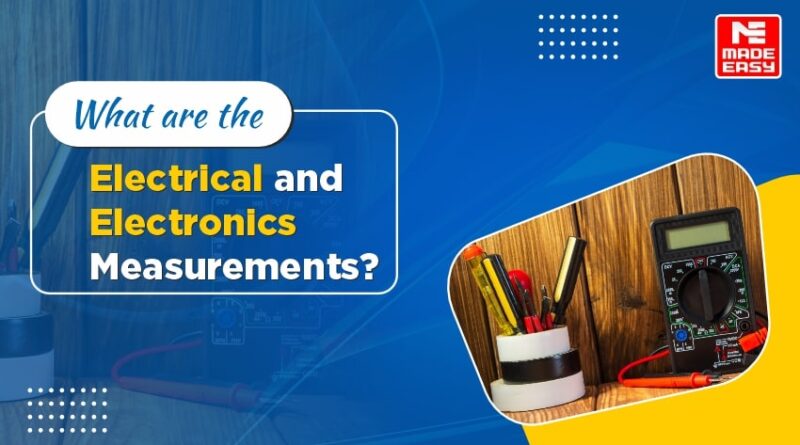What are the Electrical and Electronics Measurements?
Measurement and instrumentation systems have wide applications such as measurement of electrical and physical quantities like current, voltage, power, temperature, pressure, displacements etc.
The need for measurement arises when one wants to generate data for design or when one wants to propose a theory based on a set of measurement and instrumentation for commerce.
The measurement and instrumentation systems can also be used to locate things or events. Like employees present in a building, the epicenter of an earthquake. Sometimes, measurement systems are made a part of the control system. One can observe the change in the field of measurement and instrumentation due to the introduction of new standards, and sensors.
Given below are the links to some major and important topics related to electrical and electronics measurements that will be beneficial for aspiring electrical engineers:
Key Concepts:
Methods of Instruments and Measurement
Methods of measurements have been classified into two ways:
1. Direct Measurement
- In this method, the measured or the unknown quantity is directly compared against a standard.
- This method of measurement sometimes produces human errors and hence gives inaccurate results.
2. Indirect measurement
- This method of measurement is more accurate and more sensitive.
- These are more preferred over direct measurement.
Types of instruments:
Instruments are classified in three categories:
Mechanical
- This instrument is used for stable and static conditions.
- They are unable to respond rapidly to measurements of dynamic and transient conditions because of having moving parts that are bulky, heavy and rigid possessing high inertia.
Electrical
Electrical methods of indicating the output of detectors are more rapid than mechanical methods, but they have a limited time response.
Electronic
These instruments require use of semiconductor devices. The response time of these instruments are extremely small as a very small inertia of electrons is only involved. The sensitivity of these instruments is also very high. Faster response, lower weight, lower power consumption are some of the advantages of electronic instruments.
Now we’ll explore some reliable study material that will be beneficial for the electrical engineering students.
Courses for Electrical and electronics measurements (EE):
Having in depth knowledge and right guidance from the experts is very important to achieve success in engineering exams especially GATE, ESE, SES and many others. Especially the high competition in electrical engineering requires correct strategies and dedication to score well and have a career growth. MADE EASY courses are meticulously curated by our experts which primarily focuses on teaching from the basic level to the advanced level. Candidates who are interested in learning electrical engineering from the basics, including electrical and electronics measurements and other key topics, from renowned experts are advised to click on the below-mentioned EE courses:
- GATE : 1 Year Foundation Course
- ESE+GATE : 1 Year Foundation Course
- GATE + SES (GS) : 1 Year Foundation Course
- GATE & SES (GS) 2025-26 Live Online Foundation Course
- ESE + GATE + SES (GS) 2025-26 Live Online Foundation Courses
Recommended Books for Electrical and Electronics measurements
Books are still an essential part of learning as they offer in-depth knowledge in various topics. Learning books are well structured and provide comprehensive understanding making them invaluable for students and lifelong learners. MADE EASY Publications is one such platform for students who are looking for high quality and well structured content for their preparation. Our platform consists of government engineering exams books which are curated by a team of experts and experienced authors.
Electrical engineering aspirants are suggested to click on the links mentioned below to learn more in depth about electrical and electronics measurements:
- 2900 MCQs : Electrical Engineering- Practice Book for Junior Engineering
- GATE-2025: Electrical Engineering Previous Year Solved Papers
- ESE 2025: Preliminary Exam: Electrical Engineering Objective Solved Paper Vol-1
- SSC-JE 2022: EE Engg. Prev. Yr Conv. Sol Papers 2
- A Handbook on Electrical Engineering
FAQs:
1. What is Maxwell’s bridge?
Ans. Maxwell inductance bridge measures an inductance by comparison with a variable standard self inductance.
2. What is Kelvin Bridge?
Ans. The Kelvin bridge is a modification of the wheatstone bridge and provides greatly increased accuracy in measurement of low value resistances.
3. What is the cathode ray tube CRT?
Ans. Cathode ray tube acts as the heart of the cathode ray oscilloscope (CRO).
4. What is the electron gun?
Ans. The electron gun, which emits electrons and forms them into a beam consists of a heater, a cathode, a grid, a pre-accelerating anode, a focusing anode and an accelerating anode.
5. What is a piezoelectric transducer used for?
Ans. Piezoelectric transducers in a ring shape are used to detect changes in vibration or pressure and generate a usable electrical output.


